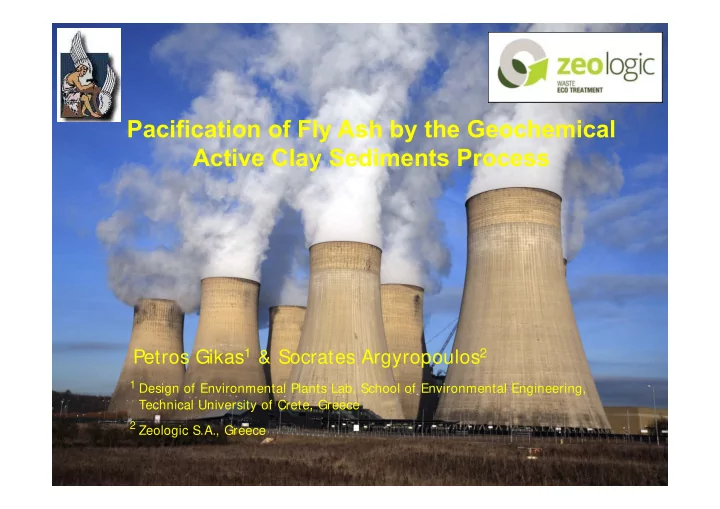

Pacification of Fly Ash by the Geochemical Active Clay Sediments Process Petros Gikas 1 & Socrates Argyropoulos 2 1 Design of Environmental Plants Lab, School of Environmental Engineering, Technical University of Crete, Greece 2 Zeologic S.A., Greece
Topics Fly Ash sources Fly Ash characteristics Utilization/treatment practices Geopolymers The Geochamical Active Clay Sediments (GACS) process Experimental findings School of Environmental Engineering Technical University of Crete
Fly Ash source School of Environmental Engineering Technical University of Crete
Fly Ash: Size and composition CaO K 2 O Fe 2 O 3 Al 2 O 3 Cu Zn Mo SiO 2 Cd Cr Ni Pb MgO As Ba Sb 0.5-100 μ m Se School of Environmental Engineering Technical University of Crete
Fly Ash facts Source: Current Sc. (2011), Vol.100 Source: http://www.tifac.org.in School of Environmental Engineering Technical University of Crete
Fly Ash: Uses Road Soil amelioration Geopolymers construction Ceramics Cement Metal recovery Directive: 2003/33/EC School of Environmental Engineering Technical University of Crete
Directive 2003/33/EC Enforces strict limits for leaching/percolation tests Especially cares for the stabilization of heavy metals School of Environmental Engineering Technical University of Crete
Geopolymers Geopolymers (active clay sediments): Three-dimensionally cross-linking alumininosilicates amorphous inorganic materials Consist of various inorganic repeating units, such as: silico-oxide (-Si-O-Si-O-) silico-aluminate (-Si-O-Al-O-) ferro-silico-aluminate (-Fe-O-Si-O-Al-O-) alumino-phosphate (-Al-O-P-O-) Geopolymerisation: A relatively complex reaction (polycondensation) between aluminosilicate- containing powders (e.g. fly ashes and/or reactive clays) with alkali metal silicates or hydroxides Portland cement Geopolymer School of Environmental Engineering Technical University of Crete
Uses of geopolymers Uses of geopolymers: • Binding materials • Ceramics • Arts and decoration • Restoration of archeological findings • Fire resistance materials • Adsorption/encapsulation of wastes Use of geopolymers for wastewater, sludge and ash treatment: • Irreversible adsorption of a large spectra of wastes (organic, inorganic, heavy metals) • Can be structured so to be adsorption-selective (eg: for heavy metals, organic wastes, radioactive wastes, etc) School of Environmental Engineering Technical University of Crete
Geopolymer School of Environmental Engineering Technical University of Crete
Fly Ash treatment by the GACS process Introduction of Fly Ash Adjustment of moisture pH adjustment Chemical oxidation (if required) Adsorption on geopolymers (georeaction-1 st phase) Aggregation by nanopolymers Georeaction-2 nd phase Drying Geopolymer type I Acid Geopolymer Nano- Oxidation Fly agent type II agent polymer H 2 O ash Hot air Stabilized fly ash Reactor Reactor Reactor Reactor Reactor Reactor School of Environmental Engineering Technical University of Crete
Raw and treated Fly Ash composition Before treatment After treatment School of Environmental Engineering Technical University of Crete
Visual observation of raw and treated Fly Ash Before treatment After treatment School of Environmental Engineering Technical University of Crete
Leaching tests according to 2003/33/EC, at L/S=2L/kg L/S = 2 L/kg Compound Measured Limit (mg/kg) (mg/kg) Al - 0.64 As 0.10 0.06 Ba 7.00 0.00 Cd 0.03 0.00 Cr (total) 0.20 0.11 Cu 0.90 0.10 Fe - 0.46 Hg 0.003 0.00 Mo 0.30 0.08 Ni 0.20 0.19 Pb 0.20 0.00 Sb 0.02 0.00 Se 0.06 0.00 Zn 2.00 < 0.02 Cl - 550 0.00 F 4.00 0.36 Phenol Index 0.50 0.00 TDS 2.500 1.900 2- SO 4 560 480 DOC 240 0.00 School of Environmental Engineering Technical University of Crete
Leaching tests according to 2003/33/EC, at L/S=10L/kg L/S = 10 L/kg Compound Measured Limit (mg/kg) (mg/kg) Al - 0.80 As 0.50 0.16 Ba 20.00 0.00 Cd 0.04 0.00 Cr (total) 0.50 0.27 Cu 2.00 0.10 Fe - 0.37 Hg 0.01 0.00 Mo 0.50 0.09 Ni 0.40 0.33 Pb 0.50 0.00 Sb 0.06 0.00 Se 0.10 0.00 Zn 4.00 < 0.02 Cl - 800 0.00 F 10.00 0.14 Phenol Index 1.00 0.00 TDS 4.000 3.400 2- SO 4 1.000 980 DOC 500 0.00 School of Environmental Engineering Technical University of Crete
Percolation tests according to 2003/33/EC C 0 (percolation test) Compound Measured Limit (mg/L) (mg/L) Al - 0.74 As 0.06 0.032 Ba 4.00 0.00 Cd 0.02 0.00 Cr (total) 0.10 0.093 Cu 0.60 0.11 Fe - 0.19 Hg 0.002 0.00 Mo 0.20 0.16 Ni 0.12 0.075 Pb 0.15 0.00 Sb 0.10 0.00 Se 0.04 0.00 Zn 1.20 < 0.02 Cl - 460 0.00 F 2.50 0.42 Phenol Index 0.30 0.00 TDS - 2.800 2- SO 4 1.500 1.105 DOC 160 0.00 School of Environmental Engineering Technical University of Crete
General view of wastewater treatment plant utilizing the GACS process School of Environmental Engineering School of Environmental Engineering Technical University of Crete Technical University of Crete
Geopolymer addition tank School of Environmental Engineering School of Environmental Engineering Technical University of Crete Technical University of Crete
Geopolymer inside the feeding silo School of Environmental Engineering School of Environmental Engineering Technical University of Crete Technical University of Crete
Filter press and sedimentation tank School of Environmental Engineering School of Environmental Engineering Technical University of Crete Technical University of Crete
Conclusions The use of the Geochemical Active Clay Sediments (GACS) process can pacify the Fly Ash Leaching and percolation tests indicated that the treated sludge complies with all the requirements of the Directive 2003/33/EC The process is ready to be applied in industrial scale School of Environmental Engineering Technical University of Crete
Thank you for your attention Correspondence: petros.gikas@enveng.tuc.gr
Recommend
More recommend